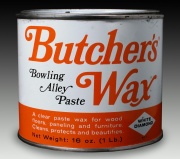Difference between revisions of "Butcher's wax"
Jump to navigation
Jump to search
(→Risks) |
|||
| (One intermediate revision by the same user not shown) | |||
| Line 8: | Line 8: | ||
Bowling Alley Paste wax (common name); Butchers paste wax; Clear paste wax; Boston Polish | Bowling Alley Paste wax (common name); Butchers paste wax; Clear paste wax; Boston Polish | ||
| − | ==Risks= | + | ==Risks== |
| − | Butchers: [ | + | Butchers: [https://www.conservationsupportsystems.com/system/assets/msds/Butchers_Clear.pdf MSDS] |
== Physical and Chemical Properties == | == Physical and Chemical Properties == | ||
Latest revision as of 09:10, 6 February 2024
Description
[Johnson Diversey] A registered trademark for wax blend first sold in 1880 in Boston by C. Butcher. Butcher's wax, also known as Bowling Alley wax, is a blend of carnauba and microcrystalline waxes blended with Mineral spirits and turpentine. Also called Butcher's wax, Bowling Alley wax has been used to clean and polish wood floors, furniture, metal, leather, and musical instruments. It has also been used on outdoor sculpture as a protective coating over Incralac.
Synonyms and Related Terms
Bowling Alley Paste wax (common name); Butchers paste wax; Clear paste wax; Boston Polish
Risks
Butchers: MSDS
Physical and Chemical Properties
- Soluble in turpentine, mineral spirits.
- Melting Point = ~ 75 C
Resources and Citations
- Butcher's Wax: Website
- G.S.Brady, Materials Handbook, McGraw-Hill Book Co., New York, 1971 Comment: p. 148
- Marie Svoboda, Conservation Survey Index, unpublished, 1997
- Conservation Support Systems, Catalog, 1997
- Product Information Comment: from can label, 1999
